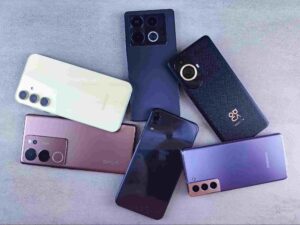
Smartphones have seen an immense transformation over the last decade, as manufacturers look to create thinner, faster, and more integrated devices. This evolution has brought on the gradual disappearance of physical SIM card trays, a trend that has accelerated since Apple released the US iPhone 14 versions without SIM trays.
eSIM-enabled devices are becoming the way to go for the latest iPhones and cutting-edge Android flagships. These models eliminate the need for physical SIMs, allowing carriers to provide connectivity remotely. For manufacturers, this means sleeker design, better water resistance, and trayless smartphones.
Read on as this article discusses why trayless smartphones are a growing trend and what’s driving this change. This article also looks at how this trend could reshape the mobile landscape, and what all of this means for product design, carriers, and end users.
What Is an eSIM-Enabled Device?
An eSIM-enabled device is simply any mobile phone, tablet, smartwatch, or any wide range of IoT devices with an in-built SIM. The eSIM has been soldered on the device’s motherboard at manufacturing, eliminating the need for a physical SIM. All that’s left to do is to download a SIM profile, and your carrier can remotely activate your mobile plan.
Here’s the typical way eSIM-compatible devices like the Google Pixel 7, Samsung Galaxy S24, or iPhone 14 (US model, which is e-SIM only) connect to a mobile network:
- Scanning a QR code from your mobile operator
- Clicking the link on the code and
- Downloading a carrier profile via a mobile app or the settings menu
More so, e-SIM compatible devices are not the same as eSIM-only devices. The latter refers to trayless smartphones, and recent trends point to the industry eventually adopting the eSIM-only models, as it allows for sleeker hardware designs amongst the many other benefits.
Why Are Brands Ditching SIM Trays?

SIM trays used to be an integral component of mobile devices, and now manufacturers are ditching them to go trayless. Here are some reasons for that:
a. Design Freedom
Modern device designs continue to look for ways to create sleeker, thinner models, and in such scenarios, every millimeter counts. Manufacturers have to find ways to reduce component sizes or totally remove them if the devices can do without them.
Without a SIM tray, manufacturers can make way for larger batteries, more advanced camera modules, better cooling systems, additional antennas for 5G or Wi-Fi 7, and one less port for exterior design. With SIM trays involved, manufacturers have always had to produce multiple regional variants to account for different SIM sizes, single vs dual markets, carrier lock-in requirements, and so on.
b. Waterproofing & Durability
SIM trays are a potential point of water, dust, or debris as they require a cutout in the exterior design, a removable seal, and manual handling to remove and insert SIM cards. Hence, trayless smartphones eliminate a significant weak point that can affect long-term protection, especially in dusty or rugged environments.
For better context, smartphones like the Galaxy S24 and Pixel 8 Pro are IP68-rated devices, but removing and inserting the SIM card breaks the water seal. Should you forget to seal it properly again, it reduces protection, and this would not be a possible scenario for eSIM-only devices.
c. Security & Anti-Tampering
eSIM-enabled devices reduce the risk of security concerns like SIM swap fraud, theft and resale, and unauthorized access. eSIMs are harder to reconfigure without device credentials, and provisioning is protected by device lock.
The eSIM feature makes consumer theft less profitable, if thieves can’t just insert a new SIM into a phone and flip it.
d. Supply Chain Simplicity
Physical SIMs create sophistication in manufacturing as the hardware will need to be tailored for different regions. One region might need dual SIM slots, another might need eSIM only, and one might need a mix of both. For manufacturers, this means higher logistics costs and SKUs.
Global Trends in Trayless Phones
Trayless smartphones did not just appear out of the blue. eSIMs have become a growing trend over the past decade since the GSMA prepared the first eSIM specifications in 2016. The Google Pixel 2 was the first smartphone to offer support for eSIMs. Before that, it was the Samsung Gear S2 3G watch that first integrated an eSIM, allowing for remote SIM provisioning.
While eSIM options have been a growing trend, Apple kicked the trend out of the market with its eSIM-only US iPhone 14 models in 2022. With this, other manufacturers have realized that it is possible to completely remove SIM trays. Newer models of the many flagship phones are learning towards eSIM-only with dual support.
According to GSMA data as of June 2024, over 441 operators worldwide support eSIM, including MNOs, MVNOs, and international roaming services. Moreover, market trends show countries like India, UAE, China, and the European Union passing telecom policies that push eSIM standardization.
These growing trends suggest that eSIM-only smartphones are poised to become the default product in the coming years.
What Makes a Device Truly eSIM-Enabled?

That a device has eSIM support does not mean that it is truly eSIM-enabled. Earlier eSIM-compatible devices were built to support eSIM as a fallback. The devices still had a SIM tray, and it allowed users to have a dual SIM option or the flexibility for travel use.
Most users didn’t even know their device models were eSIM-compatible. However, recent eSIM-enabled devices have been designed with eSIM specifically as the main way for mobile connectivity. Here are some key features that make devices truly eSIM-enabled.
- The eUICC chip (embedded Universal Integrated Circuit Card): This chip is programmed into a device and, unlike a physical SIM, it’s designed to be carrier-neutral and reprogrammable. The eUICC chip allows devices to download, store, and switch between different mobile provider profiles without a physical SIM card swap.
- Remote SIM provisioning (RSP) per GSMA standards: What makes an eSIM-enabled device is the capability to download, store, and switch between different carrier profiles. This process is the typical scanning of a QR code and using an activation link to download the necessary SIM credentials for a carrier profile.
- Firmware and OS-level support: It’s not enough to have the chip; the operating system and firmware of the eSIM-compatible device must provide native support for managing the eSIM profile. On iPhones, you can find “Add eSIM” in settings, while Androids have the eSIM manager.
- Certification by carriers or GSMA-compliant partners: Mobile network operators require certification from brands to activate their eSIM-enabled devices. The GSMA sets the global standard as well as a certification program which verifies secure data handling, interoperability, and eUICC compliance.
Before OEMs Fully Go eSIM-Only
Making eSIM devices only helps manufacturers to streamline their operations, amongst the many other benefits there are. However, there are concerns and perhaps limitations to fully going eSIM-only. Some of which include consumer readiness, carrier support, and regulatory compliance.
Interestingly, we are already seeing a phased approach of OEMs starting with hybrid models and slowly transitioning to eSIM-only models as the circumstances favour them. If you are ready to be at the forefront of the evolving landscape, reach out to us at LimitFlex for complete support on your eSIM product/service launch.





